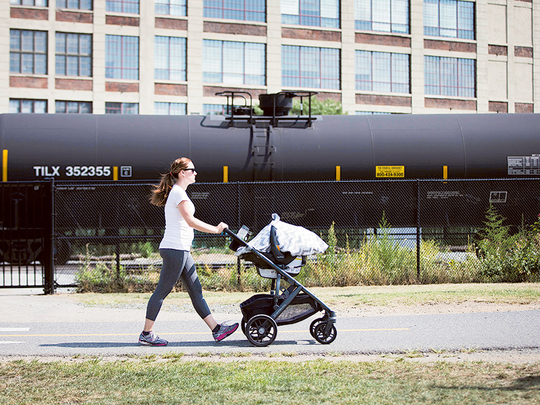
Philadelphia: They rumble past schools, homes and businesses in dozens of cities around the country — 100-car trains loaded with crude oil from the Upper Midwest.
While railroads have long carried hazardous materials through congested urban areas, cities are now scrambling to formulate emergency plans and to train firefighters amid the latest safety threat: a fifty-fold increase in crude shipments that critics say has put millions of people living or working near the tracks at heightened risk of derailment, fire and explosion.
After a series of fiery crashes, The Associated Press conducted a survey of nearly a dozen big cities that, collectively, see thousands of tank cars each week, revealing a patchwork of preparedness. Some have plans specifically for oil trains; others do not. Some fire departments have trained for an oil train disaster; others say they’re planning on it. Some cities are sitting on huge quantities of fire-suppressing foam, others report much smaller stockpiles.
The AP surveyed emergency management departments in Chicago, Philadelphia, Seattle, Cleveland, Minneapolis, Milwaukee, Pittsburgh, New Orleans, Sacramento, California, Newark, New Jersey, and Buffalo, New York. The responses show emergency planning remains a work in progress even as crude has become one of the nation’s most common hazardous materials transported by rail. Railroads carried some 500,000 carloads last year, up from 9,500 in 2008.
“There could be a huge loss of life if we have a derailment, spill and fire next to a heavily populated area or event,” Wayne Senter, executive director of the Washington state association of fire chiefs, said. “That’s what keeps us up at night.”
The oil comes from North Dakota’s prolific Bakken Shale, an underground rock formation where fracking and horizontal drilling have allowed energy companies to tap previously inaccessible reserves.
The production boom has made oil trains a daily fact of life in places such as Philadelphia, where they roll past major hospitals, including one for children. In Seattle, they snake by sports stadiums used by the Seahawks and Mariners before entering a 110-year-old tunnel under downtown. In Chicago, they’re a stone’s throw from large apartment buildings, a busy expressway and the White Sox’s ballpark.
Before the rise of shale oil and the ethanol industry, hazardous materials were typically shipped in just a handful of cars in trains that hauled a variety of products. But the trains now passing through cities consist entirely of tank cars filled with flammable crude. These so-called unit trains offer increased efficiency but magnify the risk that hazardous materials will be involved in a derailment.
That has led some residents and emergency management experts to worry it’s just a matter of time before a catastrophic derailment in a city, where, according to a 2014 US Department of Transportation analysis, a severe accident could kill more than 200 people and cause $6 billion (Dh22 billion) in damage.
Two summers ago, an oil-train derailment, explosion and fire showed the power of such a disaster in even a small town, when part of Lac-Megantic, Quebec, was levelled and 47 people died. There have been at least six oil-train derailments in lightly populated areas of the US and Canada so far this year, most resulting in fires but none in deaths.
With several trains rumbling past his Chicago home each day, Tony Phillips is keenly aware of the threat.
“If it happened here, we would be toast,” said the 77-year-old painter, who lives with his wife in a converted 19th-century factory in the Pilsen neighbourhood that shudders when one of the mile-long trains rattles past.
Phillips knows the chances of a crash right outside his bedroom window are remote. Nevertheless, when he hears the trains go by, “it gives me a little shiver”, he said. “It’s like a ghost coming along with this tremendous potential for destruction.”
Cities have responded with varying levels of urgency. Milwaukee, for example, provided basic training in crude-by-rail shipments and accidents to more than 800 firefighters, sent its hazmat team to Colorado for advanced training on oil-train accident response and meets regularly with railroad officials. Pittsburgh, meanwhile, says it has not yet conducted training exercises or met with railroad officials but will do so once its oil-train emergency plan is complete.
On the federal level, new rules aim to reduce the chances of a catastrophic derailment by lowering speed limits in cities, ordering railroads to install electronic braking systems and requiring a phase-in of stronger tank cars beginning in 2018.
The oil industry has challenged some rules in court while critics say the standards don’t go far enough, lamenting that tens of thousands of older, rupture-prone tank cars will remain on the tracks for years to come.
Some residents and activists also complain about a lack of transparency from the railroads, which have fought to keep details about oil-train routing and frequency from the public, citing competitive and security concerns. The federal government agreed in May to end its requirement that railroads notify states about large shipments of crude, but quickly reversed course amid a public backlash.
The rail industry says it shares the information with those who need it — local first responders. And, by and large, cities told the AP they work closely with railroads on emergency preparedness, getting information on cargoes and routing, and taking part in tabletop simulations and live training exercises.
Thousands of firefighters have travelled on the industry’s dime to an Association of American Railroads training facility near Pueblo, Colorado, where tank cars are set ablaze for practice. Thousands more practice diagnosing leaking tank cars at free hazardous materials workshops the industry holds around the country.












